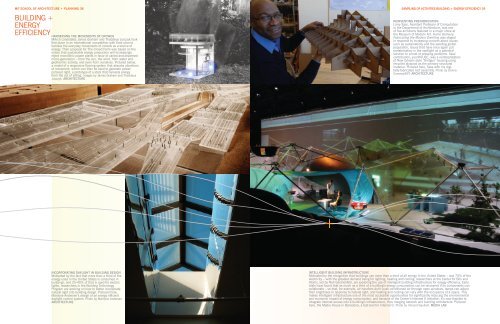Department of architecture - MIT School of Architecture + Planning
Department of architecture - MIT School of Architecture + Planning
Department of architecture - MIT School of Architecture + Planning
Create successful ePaper yourself
Turn your PDF publications into a flip-book with our unique Google optimized e-Paper software.
<strong>MIT</strong> <strong>School</strong> <strong>of</strong> ArchITecTure + PlAnnIng 38<br />
building +<br />
energy<br />
efficiency<br />
hArneSSIng The MoveMenTS <strong>of</strong> crowDS<br />
march candidates James graham and thaddeus Jusczyk took<br />
first place in an international competition with their plan to<br />
harness the everyday movements <strong>of</strong> crowds as a source <strong>of</strong><br />
energy. their proposal for the crowd farm was based on the<br />
notion that sustainable energy production will increasingly<br />
reject monolithic power plants in favor <strong>of</strong> varied and dispersed<br />
micro-generation – from the sun, the wind, from water and<br />
geothermic activity, and even from ourselves. pictured below,<br />
a model <strong>of</strong> a responsive flooring system that absorbs vibrations<br />
<strong>of</strong> movement, which can then be used to generate power;<br />
pictured right, a prototype <strong>of</strong> a stool that harvests energy<br />
from the act <strong>of</strong> sitting. images by James graham and thaddeus<br />
Jusczyk. ArchITecTure<br />
IncorPorATIng DAylIghT In buIlDIng DeSIgn<br />
motivated by the fact that more than a third <strong>of</strong> the<br />
energy used in the united States is consumed in<br />
buildings, and 25-40% <strong>of</strong> that is used for electric<br />
lights, researchers in the Building technology<br />
program are working on how to better incorporate<br />
natural light into building design. pictured here,<br />
marilyne andersen’s design <strong>of</strong> an energy efficient<br />
daylight control system. photo by marilyne andersen.<br />
ArchITecTure<br />
SAMPlIng <strong>of</strong> AcTIvITIeS buIlDIng + energy effIcIency 39<br />
reInvenTIng PrefAbrIcATIon<br />
larry Sass, assistant pr<strong>of</strong>essor <strong>of</strong> computation<br />
in the <strong>Department</strong> <strong>of</strong> <strong>architecture</strong>, was one<br />
<strong>of</strong> five architects featured in a major show at<br />
the museum <strong>of</strong> modern art. Home Delivery:<br />
Fabricating the Modern Dwelling was staged<br />
in response to increasing concern about issues<br />
such as sustainability and the swelling global<br />
population, issues that have once again put<br />
prefabrication in the spotlight as a potential<br />
solution to a host <strong>of</strong> pressing problems. Sass’<br />
contribution, yourhouSe, was a reinterpretation<br />
<strong>of</strong> new orleans style ‘Shotgun’ housing using<br />
recycled plywood as the primary structural<br />
material. pictured here, Sass with his digitally-fabricated<br />
ro<strong>of</strong> assembly. photo by Donna<br />
coveney/mit. ArchITecTure<br />
InTellIgenT buIlDIng InfrASTrucTure<br />
motivated by the recognition that buildings use more than a third <strong>of</strong> all energy in the united States – and 70% <strong>of</strong> the<br />
electricity – with the greatest demand being for lighting, heating and cooling, researchers at the center for Bits and<br />
atoms, led by neil gershenfeld, are exploring the use <strong>of</strong> intelligent building infrastructure for energy efficiency. early<br />
trials have found that as much as a third <strong>of</strong> a building’s energy consumption can be recovered if its components can<br />
collaborate – so that, for example, air handlers don’t push conditioned air through open windows, lamps can adjust<br />
their brightness in response to natural light, and heating and cooling can vary with the occupancy <strong>of</strong> a space. this<br />
makes intelligent infrastructure one <strong>of</strong> the most accessible opportunities for significantly reducing the environmental<br />
and economic impact <strong>of</strong> energy consumption, and because <strong>of</strong> the center’s internet 0 initiative, it’s now feasible to<br />
integrate internet access into a building’s infrastructure, thus merging network and building <strong>architecture</strong>. pictured<br />
here, the media house in Barcelona, a test-bed for internet 0. photo by Vincent gaullart. MeDIA lAb


